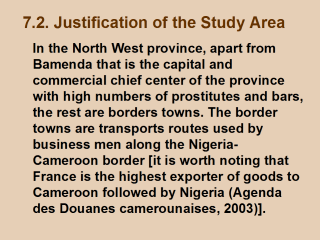| front |1 |2 |3 |4 |5 |6 |7 |8 |9 |10 |11 |12 |13 |14 |15 |16 |17 |18 |19 |20 |21 |22 |23 |24 |25 |26 |27 |28 |29 |review |
 |
Five main routes
are used by these businessmen who come from all over Cameroon: a) Ndu → Ntumbaw → Sabong Gari → Nwa → Nigeria. b) Ndu → Binka → Mayo Binka → Lus → Nigeria. c) Ndu→ Binka → Nkambe → Ako → Abongshi → Nigeria. d) Ndu → Binka → Nkambe → Misage → Dumbo→ Nigeria. e) Bamenda → Befang → Banakuma → Baworu → Nigeria. In addition, because of ethnic clashes in the Taraba and Benue states of Nigeria since two years ago, there is a concentration of pastoral refugees in Abongshie, Ako, Nkambe, Mayo-Binka, Sabong Gari, and Nwa. Because of the relative peace that reigns in Cameroon many Nigerian business men also troop into the country through these routes. Long-distant truck drivers with their characteristic multiple partners on settlements along these routes are common. Hence, these are high HIV/AIDS prone regions. Trans-border (Cameroon-Nigeria and vice-versa) transport workers on Rivers Donga and Mantung are also high risk groups. |